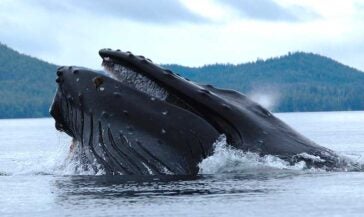 Using dental records to assess human history is nothing new. Using whale baleen to study whale life history, specifically for PFAS? That’s new. In a recent study published in Environmental Science & Technology: Letters, a group of scientists studied whale baleen, the keratin fibrous plate used to sift and filter food from water, to look for PFAS. Six species of whales were studied to assess if PFAS could be detected in baleen, and how concentrations compared to other tissues.
Using dental records to assess human history is nothing new. Using whale baleen to study whale life history, specifically for PFAS? That’s new. In a recent study published in Environmental Science & Technology: Letters, a group of scientists studied whale baleen, the keratin fibrous plate used to sift and filter food from water, to look for PFAS. Six species of whales were studied to assess if PFAS could be detected in baleen, and how concentrations compared to other tissues.
PFAS were indeed detected in the baleen samples evaluated, with at least one PFAS compound found in every sample, the most prevalent being longer chain PFAS, known to accumulate more readily in organisms. Compounds included the well known legacy PFAS perfluorooctanoic acid (PFOA) and sulfonic acid (PFOS), subject to recent Environmental Protection Agency (EPA) regulation.
The most interesting part of the research demonstrates that baleen can serve as a time series. Different parts of the baleen represent the different segments of a whale’s life, as well as the environment to which they were exposed. This is a key aspect of the study, where STEEP scientists and collaborators propose that certain trends in PFAS in baleen observed over time may correspond to life events. Some samples analyzed showed a decrease in measured PFOS during known calving times, which may be evidence of the whale offloading PFAS to its baby.
Further method development might allow for scientists to learn even more about a whale’s life history from baleen. Using smaller amounts, researchers may be able to look at more refined temporal trends, potentially for PFAS exposure and accumulation changes with seasons or locations of feeding. With this research method, historical collections of baleen in museums and collections can be analyzed to understand the history of PFAS in the oceans past the lifespan of current whales.
This research exhibits another remarkable example of how PFAS have saturated life on this planet. Whale baleen holds crucial information about PFAS accumulation in ecosystems over time, and a wealth of information from historical samples will enhance our understanding of PFAS contamination of the marine food web.
Matthew S. Savoca, Anna R. Robuck, Michaela A. Cashman, Mark G. Cantwell, Lindsay C. Agvent, David N. Wiley, Rachel Rice, Sean Todd, Nicole E. Hunter, Jooke Robbins, Jeremy A. Goldbogen, and Rainer Lohmann. Whale Baleen To Monitor Per- and Polyfluoroalkyl Substances (PFAS) in Marine Environments. Environmental Science & Technology Letters 2024 11 (8), 862-870.

